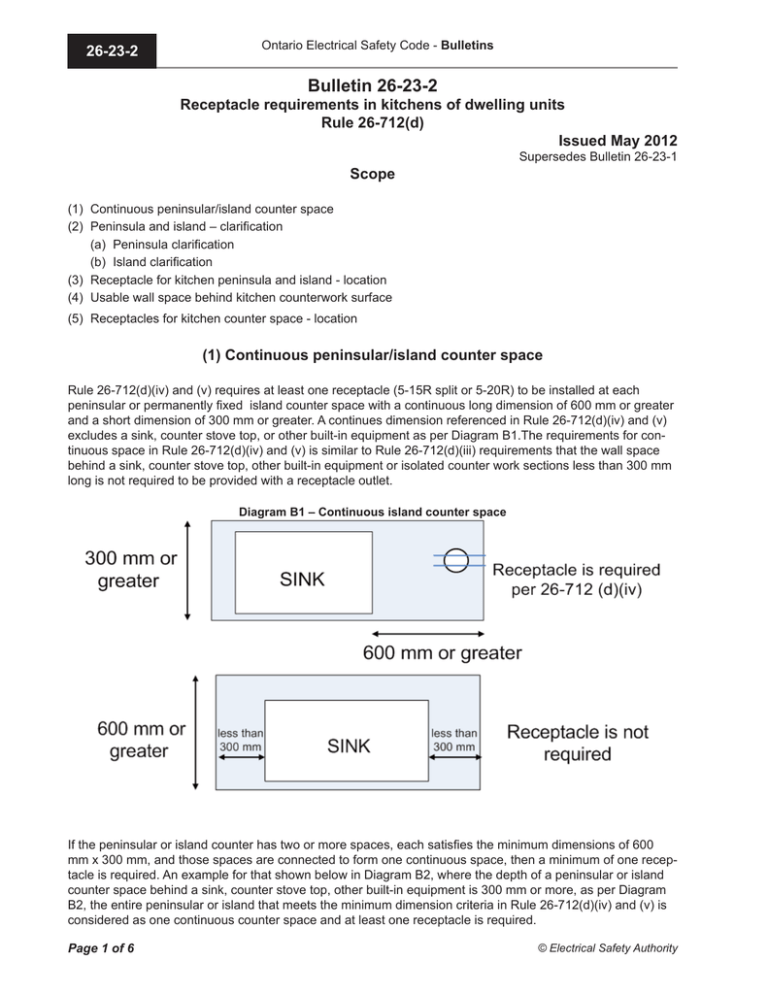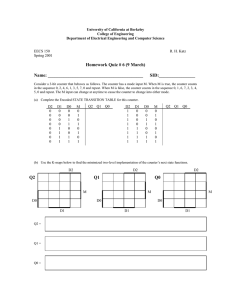Continuous Peninsular/island Counter Space
advertisement

26-23-2 Ontario Electrical Safety Code - Bulletins Bulletin 26-23-2 Receptacle requirements in kitchens of dwelling units Rule 26-712(d) Issued May 2012 Scope Supersedes Bulletin 26-23-1 (1) Continuous peninsular/island counter space (2) Peninsula and island – clarification (a) Peninsula clarification (b) Island clarification (3) Receptacle for kitchen peninsula and island - location (4) Usable wall space behind kitchen counterwork surface (5) Receptacles for kitchen counter space - location (1) Continuous peninsular/island counter space Rule 26-712(d)(iv) and (v) requires at least one receptacle (5-15R split or 5-20R) to be installed at each peninsular or permanently fixed island counter space with a continuous long dimension of 600 mm or greater and a short dimension of 300 mm or greater. A continues dimension referenced in Rule 26-712(d)(iv) and (v) excludes a sink, counter stove top, or other built-in equipment as per Diagram B1.The requirements for continuous space in Rule 26-712(d)(iv) and (v) is similar to Rule 26-712(d)(iii) requirements that the wall space behind a sink, counter stove top, other built-in equipment or isolated counter work sections less than 300 mm long is not required to be provided with a receptacle outlet. Diagram B1 – Continuous island counter space If the peninsular or island counter has two or more spaces, each satisfies the minimum dimensions of 600 mm x 300 mm, and those spaces are connected to form one continuous space, then a minimum of one receptacle is required. An example for that shown below in Diagram B2, where the depth of a peninsular or island counter space behind a sink, counter stove top, other built-in equipment is 300 mm or more, as per Diagram B2, the entire peninsular or island that meets the minimum dimension criteria in Rule 26-712(d)(iv) and (v) is considered as one continuous counter space and at least one receptacle is required. Page 1 of 6 © Electrical Safety Authority Ontario Electrical Safety Code - Bulletins 26-23-2 Diagram B2 – Large counter space behind the sink, one large island counter space However, if the peninsular or island counter has two or more spaces, each satisfies the minimum dimensions of 600 mm x 300 mm, and those spaces are separated, then a minimum of one receptacle is required for each individual space. An example for that shown below in Diagram B3, where the depth of a peninsular or island counter space behind a sink, counter stove top, other built-in equipment is less than 300 mm so that the peninsular or island countertop is separated into two spaces, and each space meets the minimum dimension criteria in Rule 26-712(d)(iv) and (v) as per Diagram B3, a minimum of two receptacles is required for the peninsular or island countertop space. Diagram B3 – Separated continuous counter spaces that meets dimensions of Rule 26-712(d)(iv) (2) Peninsula and island – clarification (a) Peninsula clarification Question 1 Does a receptacle mounted on the wall behind a counter work surface adjacent to a kitchen peninsula satisfy the requirement for the peninsular receptacle? Answer 1 No, a receptacle mounted along the wall behind a counter work surface as required by Rule 26-712(d)(iii) does not satisfy the requirement of Rule 26-712(d)(v) for the peninsular receptacle. Appendix B note to Rule26-712(d)(v) specifies that a peninsular countertop is measured from the connecting edge. An additional receptacle is required at the peninsular counter space as per Diagram B4. © Electrical Safety Authority Page 2 of 6 26 Ontario Electrical Safety Code - Bulletins 26-23-2 Diagram B4 – Receptacle requirements for a peninsula attached to a kitchen counter 300 mm or greater Peninsular K 600 mm or greater N Required by Rule 26-712(d)(iii) and not a peninsular receptacle 600 mm or greater SI Required by Rule 26-712(d)(v) and located per Direction 1 Required by Rule 26-712(d)(iii) and not a peninsular receptacle 300 mm or greater Peninsular Required by Rule 26-712(d)(v) and located per Direction 1 Question 2 Does a receptacle mounted on the wall above a standalone kitchen counter peninsula as shown in Diagram B5 satisfy the requirement for the peninsular receptacle? Answer 2 Yes, a receptacle mounted on the wall above a standalone kitchen counter peninsula satisfies the requirement for the peninsular receptacle. Appendix B note to Rule26-712(d)(v) specifies that a peninsular countertop is measured from the connecting edge and as shown in Diagram B5, the connecting edge is the wall. Diagram B5 is Code compliant. Page 3 of 6 © Electrical Safety Authority Ontario Electrical Safety Code - Bulletins 26-23-2 Diagram B5 – Receptacle requirements for a standalone peninsula 300 mm or greater 600 mm or greater (b) Island clarification Question 3 What is meant by “a permanently fixed island counter”? Answer 3 A permanently fixed island counter is one that is permanently fastened to the floor and cannot be moved without removing the fastenings. If an island is not fastened to the floor and can be moved to different locations to suit the customer’s needs, then it is not a permanently fixed island counter. Question 4 Does Rule 26-712(d)(iv) require the installation of at least one receptacle at a moveable island counter space? Answer 4 No, Rule 26-712(d)(iv) only requires the installation of at least one receptacle at each permanently fixed island counter space. If the island counter space is not permanently fixed in position, then no receptacle is required. Question 5 Does the OESC require that a moveable island counter space be permanently fixed in position and at least one receptacle installed at the island? Answer 5 No, there is no rule in the OESC that requires an island counter space to be permanently fixed in place. (3) Receptacle for kitchen peninsula and island – location Direction 1 Receptacles required by Rules 26-712(d)(iv) and (v) shall be permitted to be installed: • behind the counter work surface if the partial wall has sufficient depth and there is sufficient space in the wall cavity for the outlet box and cover without altering the trim; • in countertops, provided that receptacle outlet assemblies are certified for the application and are not mounted facing up, as specified by Rule 26-710, or • as high as can be practicably mounted on the side or end of the island or peninsula. Example of “as high as practicable” location is where a receptacle is mounted not more than 300 mm below a counter work surface. © Electrical Safety Authority Page 4 of 6 26 Ontario Electrical Safety Code - Bulletins 26-23-2 Note Where islands or peninsulas have a cantilever extension. (See Photo B1) no more than 150 mm in length, a receptacle shall be permitted on the underside within 300 mm of the top of the counter Photo B1 – Cantilever style counter top Rationale 1 Rule 26-712(d)(iv) and (v) provides the requirements for receptacles in kitchen islands and peninsulas, however it does not provide requirements for acceptable locations. The Electrical Safety Authority (ESA) has been asked by many contractors and kitchen cabinet manufacturers to clarify acceptable locations for the receptacles at peninsulas and islands. If the peninsula or island has a raised backsplash or partial wall available above the counter, as per the “Direction 6”, receptacles are permitted to be mounted on the wall above the counter (where the space exists). If the countertop is flat across its entire work surface, Rule 26-710(c) prohibits the mounting of receptacles face up in a work surface in kitchen or dining areas, which therefore requires the use of a pedestal if mounted on top of the counter surface. Most portable kitchen appliances, certified to C22.2 No. 64 Household Cooking and Liquid-Heating Appliances, are equipped with a 900 mm cord. Locating a receptacle as high as practicable on the side or end of the island or peninsula ensures that they are within easy reach of appliances located on the counter top. The example for the receptacle location within 300mm of the countertop (excluding side with breakfast bar that extends more than 150 mm) allows standard kitchen appliance cords to reach the receptacle. Question 6 Does a receptacle installed in the kick plate below an island or peninsular cabinet, satisfy the requirements of Rules 26-712(d)(iv) and 26-712(d)(v)? Answer 6 No, as per the “Direction 1”. (4) Usable wall space behind kitchen counter work surfaces Question 7 If a wall below a kitchen window/opening extends above the kitchen counter, what is the minimum height of the wall behind the counter work surface before receptacles as per Rule 26-712(d)(iii) are required? Answer 7 Receptacles shall be installed as per Rule 26-712(d)(iii) if there is sufficient space in the wall below the window/opening for the outlet box and cover, without altering the trim or building structure. When measuring Page 5 of 6 © Electrical Safety Authority Ontario Electrical Safety Code - Bulletins 26-23-2 the wall behind the counter work surface for application of Rule 26-712(d)(iii) (no point along wall more than 900 mm from a receptacle), the space between the window/opening and the counter shall be included in the measurement where there is sufficient space for the outlet box and cover to be installed. (5) Receptacles for kitchen counter space - location Question 8 Is it acceptable to install receptacles facing down, under the cabinet above the counter instead of on the wall behind the counter? Photo B2 – Receptacles installed facing down under kitchen cabinets Answer 8 Yes, provided they are located as close as practicable to the counter wall Rationale 8 Rule 26-712(d)(iii) requires that there be sufficient receptacles installed so that no point is more than 900 mm from a receptacle. With the receptacles installed on the underside of the cabinet in an approved manner this requirement may still be met. (iii) Except as permitted by Rule 26-726, a sufficient number of split receptacles along the wall behind counter work surfaces (excluding sinks, built-in equipment, and isolated work surfaces less than 300 mm long at the wall line) so that no point along the wall line is more than 900 mm from a receptacle measured horizontally along the wall line. Background 8 With the new kitchens in high end homes, the architect and builder install mirror or stainless behind the counter which makes it difficult to install receptacles along the wall. If the receptacles are installed under the cabinets, above the counter, facing down and satisfy Rule 26-712, then the counters will still be able to be serviced with receptacles without having to cut into the backsplash. © Electrical Safety Authority Page 6 of 6 26
